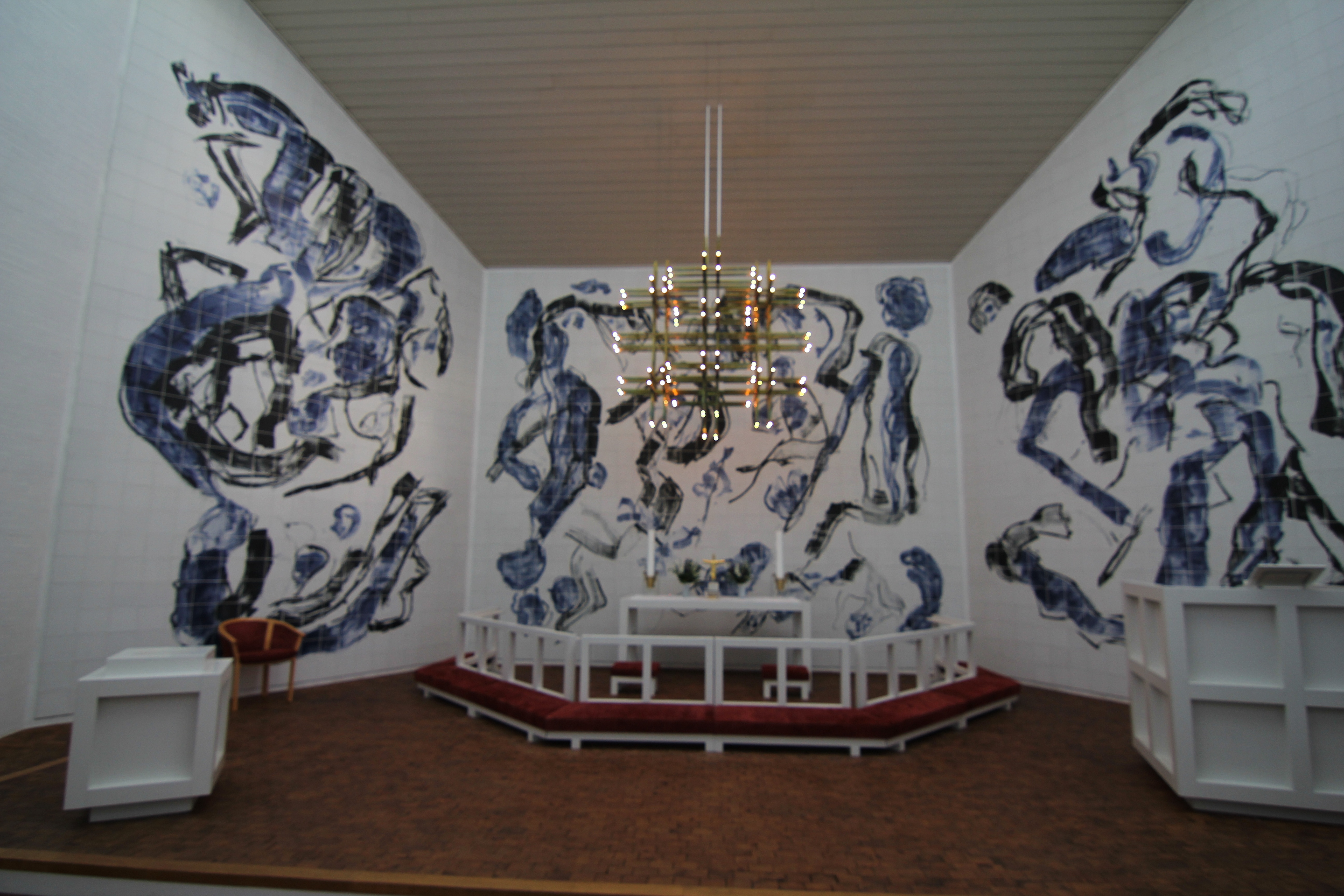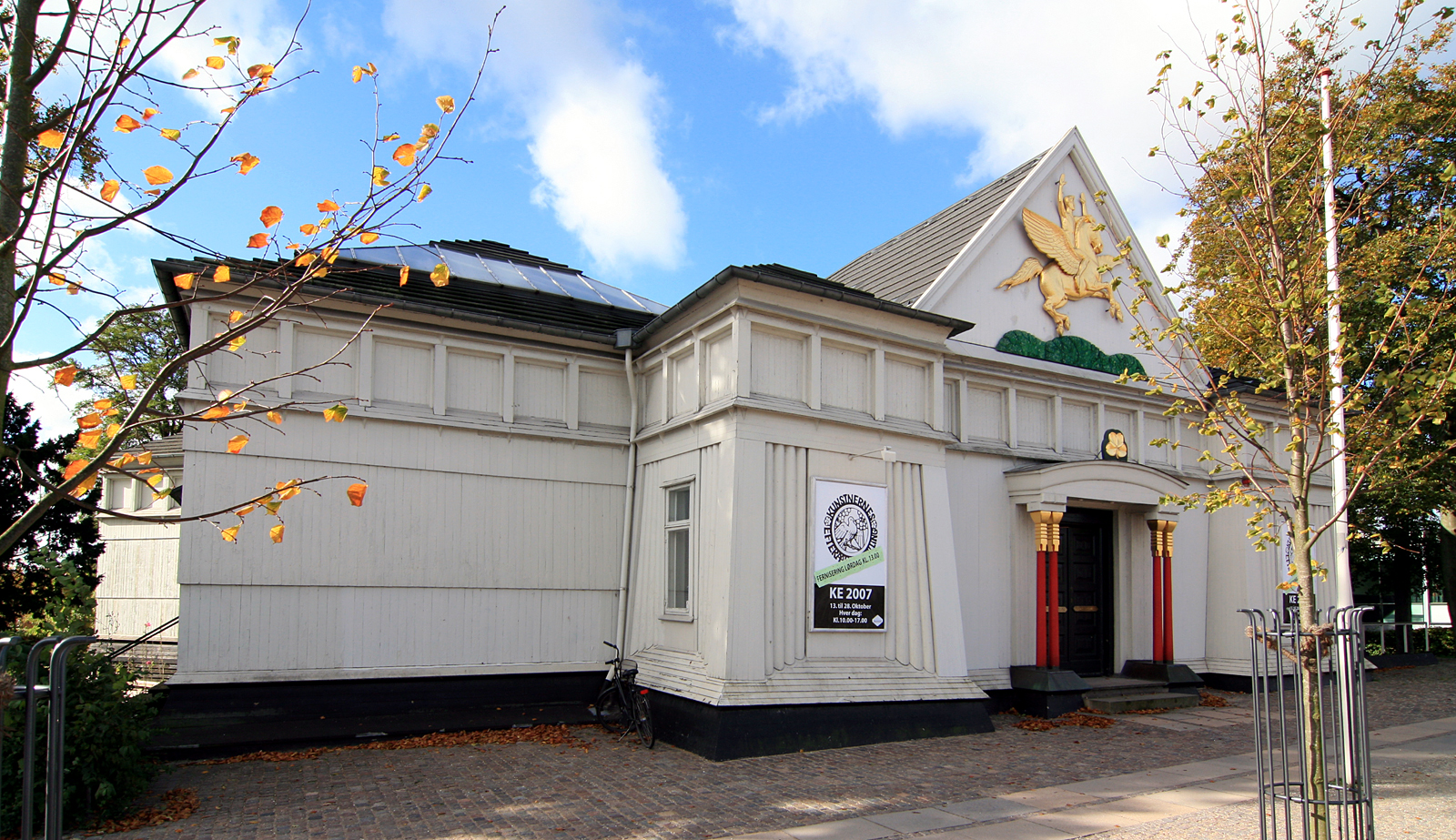|
Mogens Andersen
Mogens Helge Thestrup Andersen (8 August 1916 – 18 April 2003) was a Danish painter. Biography Born in Copenhagen, Andersen studied painting at P. Rostrup Bøyesen's art school (1933–39). He first exhibited at Kunstnernes Efterårsudstilling in 1935. His early works were earthy-coloured figure paintings but he was more interested in French Modernism. After the Second World War, he spent lengthy periods in Paris until 1965, where he was attracted by Abstract art. Thanks to his friendship with Pierre Soulages and Jean Bazaine, he developed a style of dark arabesques on a light background. Andersen's first major work in Denmark was Abstract decoration in the Central Library on Kultorvet (1959) which caused considerable discussion but there was more solid appreciation of his later assignments, including the Bochum Museum of Art (1981) and Sejs-Svejbæk Church near Silkeborg (1990). Awards In 1949, Andersen was awarded the Eckersberg Medal and, in 1984, the Thorvaldsen Medal The ... [...More Info...] [...Related Items...] OR: [Wikipedia] [Google] [Baidu] |
Thorvaldsen Medal
The Thorvaldsen Medal (Danish: Thorvaldsens Medalje, Thorvaldsen Medaillen) is awarded annually with few exceptions to a varying number of recipients by the Royal Danish Academy of Fine Arts and is its highest distinction within the visual arts. It is named after the sculptor Bertel Thorvaldsen. The medal was founded in 1837 as the Exhibition Medal and awarded for talented works in the Charlottenborg Spring Exhibition in the Charlottenborg Palace. In 1866, it was renamed the Thorvaldsen Exhibition Medal ( da, Thorvaldsenske Udstillings-Medaille), and from 1923 it has been known under its current name. Medal design The medal is executed in silver and designed by the sculptor Christen Christensen (1806–45) in connection with Thorvaldsen's homecoming from Rome in 1838. Recipients Exhibition Medal recipients Thorvaldsen Medal recipients See also * Art of Denmark * C. F. Hansen Medal * Eckersberg Medal * List of European art awards * Prizes named after people A prize is a ... [...More Info...] [...Related Items...] OR: [Wikipedia] [Google] [Baidu] |
Painters From Copenhagen
Painting is the practice of applying paint, pigment, color or other medium to a solid surface (called the "matrix" or "support"). The medium is commonly applied to the base with a brush, but other implements, such as knives, sponges, and airbrushes, can be used. In art, the term ''painting ''describes both the act and the result of the action (the final work is called "a painting"). The support for paintings includes such surfaces as walls, paper, canvas, wood, glass, lacquer, pottery, leaf, copper and concrete, and the painting may incorporate multiple other materials, including sand, clay, paper, plaster, gold leaf, and even whole objects. Painting is an important form in the visual arts, bringing in elements such as drawing, Composition (visual arts), composition, gesture (as in gestural painting), narrative, narration (as in narrative art), and abstraction (as in abstract art). Paintings can be naturalistic and representational (as in still life and landscape art, lands ... [...More Info...] [...Related Items...] OR: [Wikipedia] [Google] [Baidu] |
2003 Deaths
3 (three) is a number, numeral and digit. It is the natural number following 2 and preceding 4, and is the smallest odd prime number and the only prime preceding a square number. It has religious or cultural significance in many societies. Evolution of the Arabic digit The use of three lines to denote the number 3 occurred in many writing systems, including some (like Roman and Chinese numerals) that are still in use. That was also the original representation of 3 in the Brahmic (Indian) numerical notation, its earliest forms aligned vertically. However, during the Gupta Empire the sign was modified by the addition of a curve on each line. The Nāgarī script rotated the lines clockwise, so they appeared horizontally, and ended each line with a short downward stroke on the right. In cursive script, the three strokes were eventually connected to form a glyph resembling a with an additional stroke at the bottom: ३. The Indian digits spread to the Caliphate in the 9th ... [...More Info...] [...Related Items...] OR: [Wikipedia] [Google] [Baidu] |
1916 Births
Events Below, the events of the First World War have the "WWI" prefix. January * January 1 – The British Empire, British Royal Army Medical Corps carries out the first successful blood transfusion, using blood that had been stored and cooled. * January 9 – WWI: Gallipoli Campaign: The last British troops are evacuated from Gallipoli, as the Ottoman Empire prevails over a joint British and French operation to capture Constantinople. * January 10 – WWI: Erzurum Offensive: Russia defeats the Ottoman Empire. * January 12 – The Gilbert and Ellice Islands Colony, part of the British Empire, is established in present-day Tuvalu and Kiribati. * January 13 – WWI: Battle of Wadi (1916), Battle of Wadi: Ottoman Empire forces defeat the British, during the Mesopotamian campaign in modern-day Iraq. * January 29 – WWI: Paris is bombed by German Empire, German zeppelins. * January 31 – WWI: An attack is planned on Verdun, France. February * ... [...More Info...] [...Related Items...] OR: [Wikipedia] [Google] [Baidu] |
Eckersberg Medal
The Eckersberg Medal (originally the ''Akademiets Aarsmedaille'' or Annual Academy Medal) is an annual award of the Royal Danish Academy of Fine Arts. It is named after Christoffer Wilhelm Eckersberg, known as the father of Danish painting. The Eckersberg Medal was created in 1883, on the 100th birthday of its namesake. Eckersberg Medal recipients Source (1940 onwards)Akademiraadet 1880s 1890s 1900s 1910s 1920s 1930s 1940s 1950s 1960s *1960: Ejler Bille, Sven Havsteen-Mikkelsen, Henry Luckow-Nielsen *1961: Flemming Bergsøe, Jørgen Andersen Nærum *1962: Preben Hornung, Svend Engelund *1963: Anna Klindt Sørensen, Jeppe Vontillius *1964: Albert Mertz, Sig. Vasegaard *1965: Frede Christoffersen, Reidar Magnus, Erik Thommesen *1966: Søren Georg Jensen,Jensen Silver, The Georg Jensen Designers, http://www.jensensilver.com/news-info/designers.html (retrieved December 2008) Poul Bjørklund *1967: Poul Ekelund, Erling Frederiksen, Agnete Varming, Gunnar Westman *1968 ... [...More Info...] [...Related Items...] OR: [Wikipedia] [Google] [Baidu] |
Kunstnernes Efterårsudstilling
Den Frie Udstilling ('The Free Exhibition') is a Danish artists' association, founded in 1891 by artists in protest against the admission requirements for the Kunsthal Charlottenborg. Modeled on the Salon des Refusés, it is Denmark's oldest association of artists. Now located on Copenhagen's Oslo Plads next to Østerport Station, it works as an arts centre, continuing to exhibit works created and selected by contemporary artists rather than those chosen by cultural authorities. History The organization was initiated by the painter Johan Rohde (1856–1935) and included several founding members: Jens Ferdinand Willumsen, Anne Marie Carl-Nielsen, Vilhelm Hammershøi, Johanne Cathrine Krebs, the couple Harald and Agnes Slott-Møller, Christian Mourier-Petersen and Malthe Engelsted. The first exhibition in 1891 presented 100 works by 18 artists, including Peder Severin Krøyer, Julius Paulsen and Kristian Zahrtmann, who were among Denmark's greatest painters of the period. [...More Info...] [...Related Items...] OR: [Wikipedia] [Google] [Baidu] |
Silkeborg
Silkeborg () is a Danish town with a population of 49,747 (1 January 2022).BY3: Population 1. January by urban areas, area and population density The Mobile Statbank from Statistics Denmark Silkeborg is the seat of Silkeborg City Council (with 92,024 inhabitants as of 2018). Silkeborg is located in the middle of the ic peninsula, slightly west of the geographical centre of |
Kultorvet
Kultorvet (literally "The Coal Market") is a public square in the Old Town of Copenhagen, Denmark. Together with Købmagergade and the southern part of Frederiksborggade, it forms a pedestrian zone between Nørreport station and Amagertorv on Strøget. The square is lined with cafés and shops and is a popular venue for outdoor concerts in the summer time. Copenhagen Central Library was from the 1950s based on the square but has now relocated to a building in Krystalgade. Its old building has now been taken over by Niels Brock Copenhagen Business College. History 18th century Kultorvet was created after the Copenhagen Fire of 1728 which destroyed a large part of the city. It was initially known as ''Ny Nørre Torv oven for Rundetårn'' ("New North Market above the Round Tower"). The current, more easy-on-the-tongue name gradually took over, referring to the market trade which dominated the site. Prior to the fire, trade in charcoal, fire wood and peat had taken place just inside ... [...More Info...] [...Related Items...] OR: [Wikipedia] [Google] [Baidu] |






